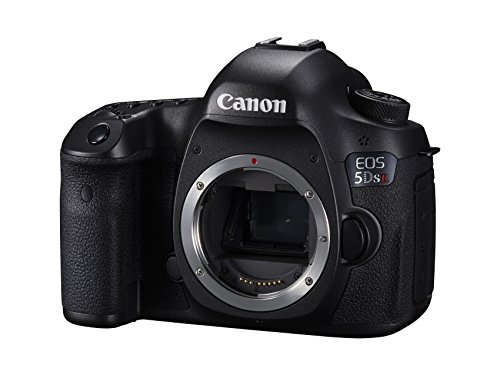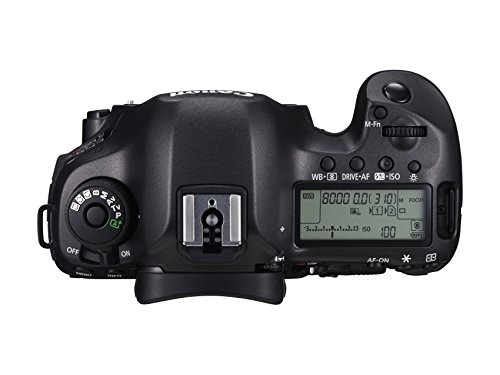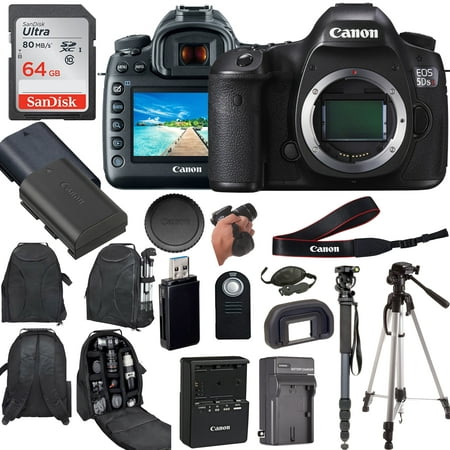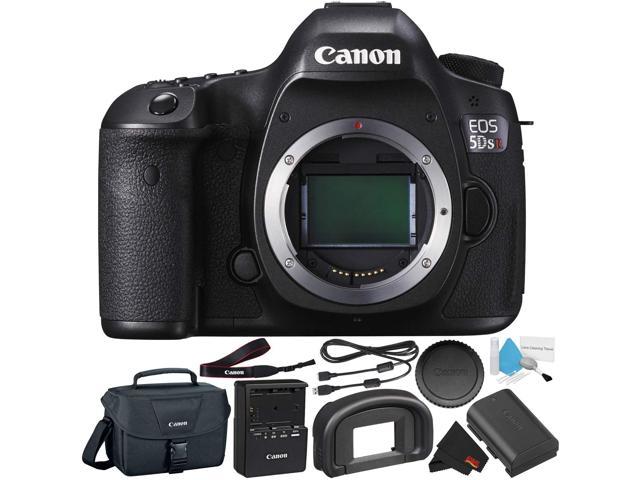Canon EOS 5DS R Digital SLR Body Only

Original price was: $3,899.00.$1,459.95Current price is: $1,459.95.
Canon EOS 5DS R Digital SLR Body Only Price comparison
Canon EOS 5DS R Digital SLR Body Only Price History
Price History for Canon EOS 80D 24.2MP Digital SLR Camera with 18-55mm Lens & 16GB Top Bundle
Statistics
| Current Price | $1,057.98 | July 25, 2024 |
| Highest Price | $1,057.98 | July 25, 2024 |
| Lowest Price | $1,057.98 | July 25, 2024 |
Last price changes
| $1,057.98 | July 25, 2024 |
Canon EOS 5DS R Digital SLR Body Only Description
Best Canon EOS 5DS R Digital SLR – Body Only
There are few cameras that can even come close to the impeccable imaging quality of the Canon EOS 5DS R body. This digital SLR is the crème de la crème of all cameras, with an excellent feature set and incredible image quality. It is not only a camera suitable for professionals and amateurs alike, but a masterpiece in its own right. Whether you’re a beginner photographer or a professional photographer, you’ll appreciate the remarkable level of quality that comes with the Canon EOS 5DS R body.
50.6MP of Preservation-Quality Resolution
At the very center of the Canon EOS 5DS R’s capabilities is an amazing resolution of 50.6MP, offering unparalleled detail for capture and preservation of your memories. With its nano-USM AF and new rgb+IR metering multi-layer sensor, the autofocus features are revolutionary in terms of speed and accuracy, while the Dual DIGIC 6 processors allow the camera to fire off magnificent shots with incredible speeds.
High Sensor Resolution and Sensitivity
The Canon EOS 5DS R digital SLR body is outfitted with a high-resolution full-frame CMOS sensor, which is perfect for capturing landscapes, portraits, and studio shots with high resolution up to 5472 x 3648 pixels. And with a fantastic ISO range of 100-12,800 (expandable up to 50-102,400, you can be sure to capture even the most fleeting moments in stunning clarity.
Unique Low-Pass Filter Effect
The Canon EOS 5DS R also features a unique low-pass filter effect, which works to give layers to your photographs and create a vibrant, high-quality image. This filter ensures that the image doesn’t suffer from moire patterning, which helps to keep colors the way they should be without smears or lose of detail. This is especially useful for shooting subjects with a high-pattern and small textures, such as wild life or architecture.
Redesigned Viewfinder and Shutter Unit
The EOS 5DS R body is optimized for speed and accuracy through a redesigned viewfinder and shutter unit. To help minimize the mechanical and electronic shake of the camera, the shutter unit is designed to open sooner and stay open for a longer period of time. This helps when shooting in low-light or other difficult lighting conditions. The viewfinder is a stunningly sweet 100% field of view, giving you the best view of what’s happening and what can be expected.
Fantastic Durability and Water-Resistant
Weighting in at 850g with great build quality that combines magnesium alloy and polycarbonate for strength and durability, you can be sure that the EOS 5DS R is made to withstand the rigors of any job. It can also withstand the occasional bang on the doors and drops onto carpets, and with its weather-resistant build, you don’t have to worry about taking gorgeous images in even the harshest of climates.
Affordable Price for Top-Of-The-Line Image Quality
The Canon EOS 5DS R is one of the best digital SLRs on the market and you certainly get what you pay for. It is quite honestly an investment, but it’s one that will pay dividends with the stunning images you will be able to capture. It may be priced higher than many others, however its powerful features and superior image quality are well worth the splurge.
Features:
- 50.6MP full-frame sensor resolution
- Dual Digic 6 Processor
- ISO range of 100- 12,800, expandable to 50 – 102,400
- Unique low-pass filter effect for layering images
- High-resolution viewfinder
- Weather-resistant build
- Portable body weight of 850g
- Fast and accurate autofocus
- Built-in WiFi
- 5 frames per second (fps) continuous shooting
FAQs on the Canon EOS 5DS R:
- What type of image sensor is the Canon EOS 5DS R equipped with?
The Canon EOS 5DS R has a 50.6MP full-frame CMOS sensor. - What is the ISO range of the Canon EOS 5DS R?
The Canon EOS 5DS R offers an ISO range of 100- 12,800, and is expandable to 50 – 102,400. - What type of low-pass filter is the Canon EOS 5DS R equipped with?
The Canon EOS 5DS R has a unique low-pass filter effect, which works to give layers to your photographs and create a vibrant, high-quality image. - How many frames per second can the Canon EOS 5DS R shoot?
The Canon EOS 5DS R offers 5 frames per second (fps) continuous shooting. - What type of autofocus is available on the Canon EOS 5DS R?
The Canon EOS 5DS R features a nano-USM AF and new rgb+IR metering multi-layer sensor for fast and accurate autofocus. - Does the Canon EOS 5DS R have a weather sealed body?
Yes, the Canon EOS 5DS R has a weather-resistant build for capturing images in all types of weather conditions. - What type of viewfinder does the Canon EOS 5DS R have?
The Canon EOS 5DS R has a high-resolution 100% viewfinder for a clear and detailed view of the frame. - Does the Canon EOS 5DS R have Wi-Fi connectivity?
Yes, the Canon EOS 5DS R has built-in Wi-Fi for easy sharing of photographs.
Canon EOS 5DS R Digital SLR Body Only Reviews (7)
7 reviews for Canon EOS 5DS R Digital SLR Body Only
Only logged in customers who have purchased this product may leave a review.



























PureClassA –
Well after months of waiting on pre-order, it finally arrived. Here’s the high points thus far:
1) The build and feel is 99% identical to a 5D3, which is fantastic ergonomically, and experienced Canon shooters will feel right at home with this one. It’s solid, study. weather sealed, and the mode dial got a nice little upgrade with raised icons and what seems like a bit more solid grip. The new LPE6N battery provides longer life but I’m using my old LPE6 (standard) in it just fine right now. Dual Digic 6 chip do suck up a lot of juice.
2) The lag time between the shutter and the jpg preview popping up on the rear LCD is a little longer than the 5D3, but that’s to be expected as we’re talking 70MB RAW files here. Yes, 70MB.
3) Speaking of the shutter, the sexiest thing about this camera (besides the red “R”) is the new shutter and it’s new sound. It’s like a sniper rifle with a silencer. It’s very stealth and sleek with it’s new all motor driven mechanism (as opposed to the old standard motor lift and spring return). By the way, the RGB+IR metering system they brought down from the 1DX for this? Awesome. Love it. I feel like the metering has been more accurate than my 5D3, and I’ve even used the 1DX many times myself.
4) I’ve been handheld shooting with a Canon 135 f2 L. First of all, what a lethal combo with this new 5DSR. Wow. Resolution is off the charts good. I found handheld shooting certainly requires a bit more care than the 5D3 to get the most out of the sensor, but we all knew that going in. This is a studio/tripod loving camera. HOWEVER, you can get really good results going about 4-5 times focal length with your shutter speed. (50mm lens x 5 = 1/250th second). Of course, having IS on your lens really helps. By the way, add “Mirror LockUp” to your custom menu (the green tabs). This way you can go in quickly and alter your shutter release lag time if need be, which is precisely why they built the new shutter. That way, you press the button, and the mirror flips up and the camera waits anywhere from 1/8 to 1 second before dropping the curtains on the sensor. You can set it in that range or just turn it off, or engage traditional old manual mirror lock up with the first button press lifting the mirror and the second button press dropping the curtains.
5) I can’t get this thing to Moire. I have deliberately shot some really small fabric patterns and weaves, brickwalls, so on and so forth, I can’t get it to create the negative artifact. Without the Low Pass Filter effect (this camera has TWO LFPs that cancel each other out to raise sharpness) the propensity for generating Moire and Aliasing goes up…. THAT SAID, at 50MP even the smallest details can get resolved well, so artifacts don’t really seem to be a problem so far. Now I know I have some dancers I shoot that wear silky shiny dresses with tight fabric weaves and I suspect I may encounter some color moire there. However… Lightroom’s Moire tool does a really good job to easily and quickly remove it if need be.
6) This is NOT NOT NOT a general use, everyday camera. Please get a Canon 5D Mark III (5D3) for that or the amazing 6D for half the price of 5D3. The 5DS and 5DSR really are for professionals who need the ultra high resolving capabilities for a variety of reasons such as Large Print work, studio work, pictures of large groups, architecture and landscapes, and the ability to shoot wide and crop in post without losing details. You don’t want to buy this camera to take family pictures. It’s overkill and the file sizes, as I mentioned before, are enormous. I own both the 5D3 and 6D. Both are excellent cameras and both are excellent general purpose cameras.
7) Buy Glass. Don’t buy this camera expecting the world from even your 24-105 F4 L lens. I have one. Good lens. 5DSR DOES make it look better than on a 5D3… BUT, if you really want to take advantage of what this machine can do, you need to look into some of the upper level L glass like the the new 16-35 f4 L or the 70-200 f2.8 IS II. The 135 f2 L is STILL one of the sharpest lenses ever made and looks gorgeous on this, as do the new Sigma ART lenses. (Everything I just mentioned, I own and have shot on this 5DSR now)
8) ISO performance – Ok it’s a studio and landscape camera. It’s meant to be shot at or near base ISO, right? (100-800). Well last night I shot a bunch of stuff in my house handheld at 6400 ISO. Lemme tell ya… It looks…really….nice. For all the flak on how much this camera would suck at higher ISOs I think it looks no worse than a 5D3 and maybe even a bit better (again, mostly dependent on your technique.) I would suggest as I always do with higher ISO… ETTR. Expose To The Right. Push your camera exposure compensation UP one stop and pull back highlights in post if need be. I think the 5DSR images at 6400 are really very clean for that sensitivity, but everyone has their own personal feelings about what is “usable” Not here to debate. That’s just me. I’d put the 6400 ISO performance on par with a 6D. I’m perfectly happy with it.
9) If you’re a pro who needs the juice. Buy this. You will not regret it. It’s an excellent and well built professional tool. I can’t wait to do a REAL studio test with this. I will update as I do.
UPDATE: 6/24 – Posting pictures shot with this seems futile given how images are compressed to post on the review, but here ya go: (Handheld shot using the Canon 16-35 f4 L on the Boat and Canon 135 f2 L on the girl)
UPDATE: 6/26 – I have run across an owner or two who have gotten very minute amounts of Moire in some extreme situations (wildlife in this case). But nothing that wasn’t quickly corrected in Lightroom without any damage to the image quality. That said, I still have not had the issue. It confirms my second thoughts when I cancelled my initial order of the 5DS in favor of the 5DSR
UPDATE 7/14 – First studio shoot last weekend was a big success so far as I’m concerned. Was amazed by how much detail was retained on the face and hair even from half and full length poses. Headshots were amazing. EVen though you tend to soften the skin in post, the ultra fine details you can retain where you really want to keep it (eyes, eyelashes, eyebrows, hair, etc) is uncanny. Very happy with the results. It’s being able to crop in and turn a wider shot into headshot and still have the same resolution in so doing as I would had I just taken a headshot with the 5D3. Loads of flexibility!!!
UPDATE 7/21 – Someone posted a good question about the contrast and saturation compared to other popular current Canon models like the 5D3. Yes, contrast and particularly color saturation seem to be more and richer. Canon previously stated months ago that this camera would be using a better CFA (Color Filter Array) more akin to those of the vaunted and still loved Canon 1Ds III. I just two days ago did direct comparisons between the 5D3 and 5DSR and concur this indeed seems to be the case when I had both cameras in a controlled situation in a studio setup using the same lens, exposure settings, strobe power, and even manually set white balance of 5600k on both cameras. The 5DSR naturally produced a bit warmer and richer color palate (as in zero LightRoom adjustment on both cameras)
UPDATE 7/27 – Took the R to a small play my kids were in. 70-200 f2.8L IS II running in ISO 6400 the whole way through. Keeping at f2.8 I was getting anywhere from 160th to 320th in Aperture Priority mode with changing stage lighting. (Shooting RAW as always) Gotta say I’m still very pleased with the results, and even more so after a bit of NR added in Lightroom in the Luminance channel.
UPDATE 8/3 – DIFFRACTION LIMITS – Ok this is a bit more technical for us geeks but in general, all lenses become diffraction limited around f16, which has in recent history been correct with all our 20MP-ish cameras. Diffraction limits are correlated to pixel size and density though. So at 50MP, the same lens that was DL at f16 on a Canon 5D III is now DL between f11-f14 on a Canon 5DS. I have shot many frames at f11 on my 5DSR and they look amazing (using Canon 16-35L f4 IS). The diffraction effects will start creeping in beyond this, so effectively f11 is the smallest aperture you can stop down to before you begin to LOSE sharpness. a 5D III gets you to f16 because the pixels are much bigger than the 5DS. With the smaller pixels, more fine detail can be resolved so the DL hits sooner (bigger aperture). If you shoot a lot of Macro stuff I don’t see much ever done smaller than f11-f14 anyway. So this should not be a problem. As for landscapers, f11 on a serious wide angle lens (assuming you’re using good focus point technique) should get you close to infinity focus through the frame anyway. If you really need deeper focus, then consider focus stacking anyway. I don’t think I’ve ever shot anything at f16 more than once or twice even on my 5D III.
carverest –
This is my first full frame camera, I have to compare with my previous cameras: The T3, T3i and T6s.
The Canon T3 was a good camera. It did one thing right: Take pictures. However, the T3i had a delayed trigger of 10 seconds that the other didn’t have. I evolved.
This camera is a full frame receptor, so the body is bigger than the T series. This does not have an incorporated flash, but it does have a hot shoe for a flash. You never want to use the integrated flash because it makes horribly flat light: I’ve used it. Often. The 5Ds doesn’t have one, I’ll need an external flash handy.
This 5Ds does not autofocus while doing video. Nor does it have a touch screen. The T6s does. Neither of them can make 4K video. If 4K is what you want, look somewhere else.
Not all Canon lenses work on this model, EF-S lenses don’t work.
It isn’t clear so I had to do some research, some TAMRON lenses for Canon do work on this full frame. My Tamron 90mm works, my Tamron 150-600mm zoom works. DO NOT WORK on a full-frame: Tamron 18-55mm and Tamron 18-200mm, they cause a black halo around the picture.
This 5Ds is bigger, heavier and more expensive than the T series. It’s also weatherproof. It beats most cameras with the pixel count. I’ve been told it’s not made for videographers, more for photographers.
I have become a photographer along the way, making miracles with nothing. I had a T3 with 12 megapixels and got great images. I had a powershot before that and had a ton of fun. Now I’m a bit intimidated. I just might read the manual for this camera. I usually don’t.
This is big. I hope you get to enjoy this too.
Rigo –
The controls were in Korean so after contacting the seller, who provided a link to downloadable instructions, all went well. Needed foremost was the in-camera switch over to English. The camera was new and met all my expectations.
Rigo –
Excelente resolución y muy silenciosa en obturación, faltó mejorar el ISO, agregarle WiFi y GPS. Es ideal para ambientes controlados como foto de estudio, paisajes y algunos otros.
Mark –
SIMPLEMENTE FABULOSA. CAMARA PROFESIONAL PARA MEJOR DEFINICION Y TAMAÑO MÁS GRANDE DE FOTOGRAFIA. SI ERES AFICIONADO, AMATEUR O PROFESIONAL, ES MUY RECOMENDABLE ESTE MODELO DE CÁMARA REFLEX
Amazon Customer –
It was shipped in about one week from Quebec to Calgary AB. It is a genuine Canon product, I have confirmed the serial number. It came in a genuine box with all original accessories. However, the box was opened. This is likely for inspection at the border and/or to replace the Asian plug with a North American one, because inside nothing else appears to be opened, camera was pristine. Note that because this is intended for the Asian market Canon will not honour the warranty in CAN/USA. Don’t be alarmed, just purchase a 3rd party warranty through amazon when you buy it. 3rd parties will honour the warranty and use local Canon certified repair technicians, just ensure you purchase the warranty with the original purchase of the camera on the same amazon order. Local Camera shops or repair depots may refuse to touch it, even for an out of warranty repair. The camera was in Chinese out of the box, I had to figure out how to change the language to English, not a big deal really. Still a great value for the price, just be aware this is considered a “grey market” camera, and you must assume the risks involved. I wish sellers would make this clearer in product descriptions for buyers to be aware, I think Amazon should start enforcing this. I have only used the Camera for a couple days with a few hundred test shots, works flawlessly. I did update the firmware successfully also. Overall I am happy with the purchase and would recommend it to anyone, assuming they understand the risks.
PureClassA –
I’ve burnt more than a few brain cells over the last couple of months trying to decide on which way to go, Canon’s 5DSR or Sony’s A7RII. Fortunately, after selling a house and liquidating some gear, I decided to plunge into the best both of worlds and pick up both bodies. Here are some thoughts specifically on the 5DSR with regard to touted items off its marketing literature as well as topics of interest relative to the Sony body. Hopefully, I’ll cover a few topics not hit by others.
– ISO6400 Limit – I never really had a need to go past 6400 on any body given the grain that is added. So I don’t see this as a limiting factor. The noise added on the A7RII is also quite appreciable and oddly, prefer Canon’s signature. I have not used the A7S or the new A7SII so the grain may be less noticeable on those bodies given the larger pixels.
– Mirror Lock-Up Delay – On the Canon 5D3 for years, I used the 10-second delay with Live-View which basically did the same thing and creates an electronic first-curtain. Marketing at its best here.
– Pixel Noise – Both bodies have visible noise when images are magnified (pixel peep); with the Canon there is a bit more however, at base ISO settings. Given the 5DSR has more resolution, you can sacrifice some of that by dialing in a bit more noise reduction bringing the noise level to about the same. At higher ISO settings, the noise looks to be similar between the two. However, if your aim is going for exposures longer than 2 minutes, I can’t recommend either body and would recommend a 20-something MP body. It seems those little pixels get hot quickly on both the Sony and Canon and leave hot-pixel artifacts.
– Dynamic Range – Yep, the A7RII has more DR, it’s well documented, at native ISO settings. What’s not well talked about is the DR is about the same from ISO1600 onward. Further, if one exposes correctly, you shouldn’t need to pull 5-stops of shadows up, which cause photos to look a bit baked. This topic is a bit overblown (sorry couldn’t resist that pun). I must admit however, the raw files coming out of the Canon have a higher contrast than the Sony, I wonder if the processing is artificially destroying some DR bandwidth and clipping the shadows and highlights – unfortunately, I leave that answer to those who more technical than myself.
– Lenses – There are some pretty good lenses native to the Sony mount and Sony’s stable is getting bigger and better all the time, largely with the help of Zeiss (love those Loxias). But if you need scalpel-sharp images availing a high megapixel sensor, the EF mount is really the only place you will find what you’re looking for right now for anything on the Canon or the Sony. Some lenses on the EF mount simply don’t have a Sony-mount peer – ironically with the help of Zeiss (think Otus & APO135). The new 35mm f/1.4L II and 300mm f/2.8L IS II also really make the 5DSR sing. Mounting any of these EF lenses to the Sony negates any idea of a small inconspicuous package.
– Focus – Focusing Canon lenses on the A7RII is better now than on previous models, but still not quite as good as on a Canon body. The longer telephoto and super-telephoto’s are not so good on the Sony.
– Build – This one is pretty clear to me, I have taken a 5D3 out in rainstorms and torrential blizzards where I’ve had to chip away at the ice that collected on the body – no problems over the years of abuse with operations and functions. I assume the 5DSR is at least as rugged. I just don’t have that same confidence in subjecting the Sony to the same abuse – time might tell if I get brave and I’ll report back.
– Ergonomics – I really wish I could re-assign the magnification button to somewhere on the right hand so I can hit LiveView and magnification without having to bring my left hand back behind the camera (it’s usually holding a heavy lens. Otherwise, those coming from a Canon 5D# or 1D# body should come up right to speed with the 5DSR. P.S., the Sony isn’t as bad as everyone says it is once you get accustomed to where things are.
– Moire – Not normally a problem, but there have been a few instances of shooting buildings where I get patterns on the shades in the windows and of the air-duct exhaust fins on buildings, but usually only see them when zoomed in. Very little problem here.
Generally, between the two models and all the hype/bash that was floating around, the Canon 5DSR compared more favorably (maybe my expectations were low) and the Sony A7RII compared less favorably (maybe my expectations were high) – so it seems reality is somewhere between all the hubbub.
My only advice is to know what you’ll be using the camera for, don’t get upset that the screwdriver you bought is not able to pound in the nails like a hammer. If you need insane resolution where you’ll be blowing up prints that people will actually be viewing up close to (versus a billboard), Canon has produced a wonderful tool for architecture, landscapes, macro, portraiture, etc., and this might be your ticket. But the 5DSR is remarkably unforgiving to a lazy or casual photographer that relies on post-production to get things right.
If undecided, go out and rent them to find out which fits you best. Both are remarkable tools and should fully satisfy your needs, if those needs fall within each camera’s respective capability. Peace & Happy Shooting!